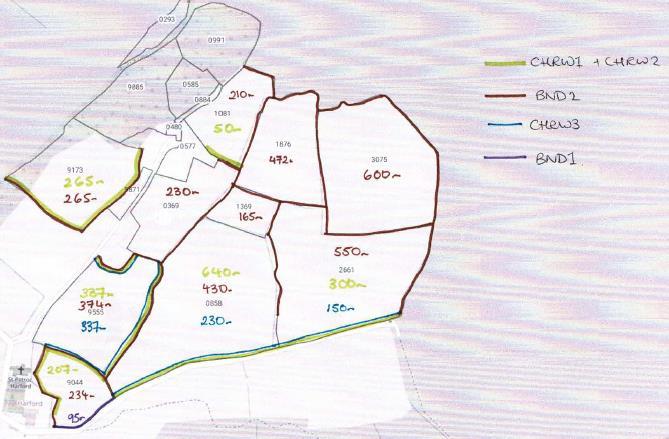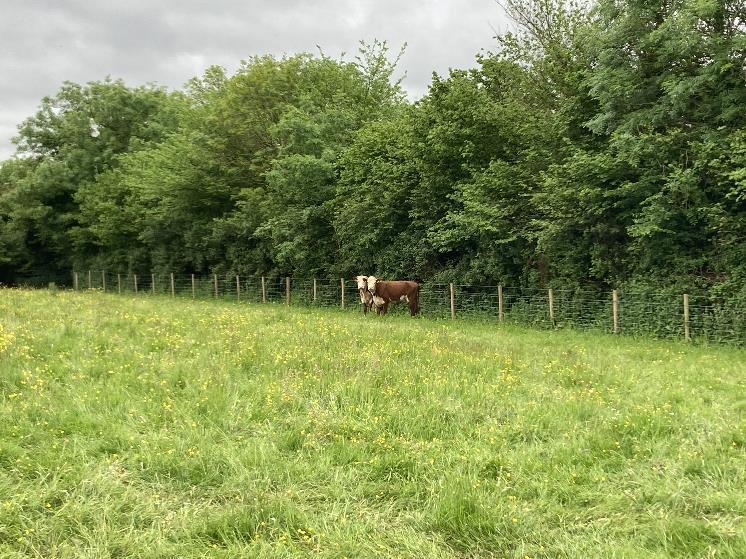

SFI Hedges Workshop
January 2025
Overview:
What are the hedge options in SFI?
How do I prepare my SFI application for hedges?
How do the options fit with other schemes?
Capital works for hedges
When is a hedge not a hedge?
In Defra terminology for the SFI hedge options:
• a boundary line of shrubs, or both shrubs and trees
• over 20m long
• less than 10m wide
• Can be newly planted, laid or coppiced
• woody growth on top of an earth or stone-faced bank, for example, Cornish or Devon hedges
CHRW1: Assess and record hedgerow condition
£5 per 100 metres for one side of an eligible hedgerow per year
This action’s aim is that you understand the condition of your hedgerows and effectively plan how they can be managed to improve their condition
Assess the condition of the hedgerows and complete a written assessment record within the first 12 months. Review the condition of the hedgerows and update the hedgerow condition assessment record in each subsequent year.
Must be over 20m long and less than 10m wide
The hedgerow can be newly planted, laid or coppiced, and/or woody growth on top of an earth or stone-faced bank, for example, Cornish or Devon hedges
There can be gaps in the hedgerow if they’re not more than 20m long and 10% of the total length of the relevant hedgerow when you add all the gaps in it together
There are templates and forms available but how you do it is up to you. Can be on a map, digitally, spreadsheet etc.
Guidance: https://hedgerowsurvey.ptes.org/healthy-hedgerows-survey-guidance
Healthy hedgerows – key structures

CHRW2: Manage hedgerows
£13 per 100 metres for one side
The purpose of this is to provide:
• habitat for wildlife
• pollen, nectar and berries for mammals, birds and insects
For fully established hedgerows, if you’re cutting them:
• incrementally, you must do this during the autumn and winter months (usually September to late February), each year of this action’s 3-year duration
• on a rotation no more than once every 3 years, you must do this during the autumn and winter months
• on a rotation no more than once every 2 years, you must do this in late winter (usually from early January to late February)
For newly planted hedgerows, or hedgerows which are not fully established, you must lightly trim them incrementally:
• during the autumn and winter months
• each year of this action’s 3-year duration
If you choose to cut your fully established hedgerows incrementally, you can do this by increasing the height and width of each cut by about 10 centimetres (cm) compared with the previous cut.
Is equivalent of BE3 in Countryside Stewardship
CHRW1 and CHRW2:
You can do this action on either one side or both sides of an eligible hedgerow unless you’re managing a fully established hedgerow in a coppicing or laying rotation. In this case, you must enter both sides of the hedgerow.
You must have management control of one or both sides, depending on what you enter into this action.
You can enter both sides of a roadside hedgerow, or a hedgerow that borders a neighbour’s land, if you meet both of the following:
• you have a legal right or obligation to maintain the hedgerow
• you can meet this action’s requirements
CHRW3: Maintain or establish hedgerow trees
£10 per 100m for both sides
This action’s aim is that there are hedgerow trees maintained or established.
The purpose of this is to provide habitat for wildlife and carbon storage benefits
Make sure there’s an average of at least 1 hedgerow tree per 100m over the total length of hedgerows entered into this action. This means some 100m lengths can contain no trees, as long as you meet this average.
• You can do this action by:
• maintaining existing trees growing within the hedgerow
• establishing new hedgerow trees
• You can only do this action on both sides of an eligible hedgerow. This means you must have management control of both sides of the hedgerow
• You can enter both sides of a roadside hedgerow, or a hedgerow that borders a neighbour’s land, if you meet both of the following:
• you have a legal right or obligation to maintain the hedgerow
• you can meet this action’s requirements
BND1: Maintain dry stone walls
£27 per 100 metres (m) for both sides
Should be:
of traditional dry stone wall construction, which can include mortar if it’s part of the traditional stone walling method
• at least 20m long, measured between 2 end points
• in good condition. To be in good condition, the dry stone wall must be both:
• continuous – which means there are no gaps along its entire length, apart from structural wall features such as stiles, stone gate posts and sheep creeps
• complete – which means the wall is at a height in keeping with local style, with top stones in place if they’re part of the local style
You can only do this action on both sides of the entire length of an eligible dry stone wall. This means you must have management control of both sides of the wall.
You can enter both sides of a roadside wall, or a wall that borders a neighbour’s land, if you meet both of following conditions:
• you have a legal right or obligation to maintain the wall
• you can meet this action’s requirements
BND2: Maintain earth banks or stone-faced hedgebanks
£11 per 100 metres (m) for one side
To be eligible for this action, the bank must be:
• either a raised earth or turf-faced bank (an earth bank), or a raised earth bank faced with natural stone (a stone-faced hedgebank) – there can be woody growth on top of the bank (for example, Cornish or Devon hedges)
• distinct from the surrounding landform
• a land parcel boundary
• at least 20m long, measured between 2 end points
• in good condition
To be in good condition, the earth bank or stone-faced hedgebank must be both:
• continuous, with no gaps along its entire length
• complete, so the bank is at a height in keeping with local style and a stone-faced hedgebank has facing stones in place
You can do this action on the entire length of either one side or both sides of an eligible earth bank or stone-faced hedgebank. You must have management control of one or both sides, depending on what you enter into this action.
You can enter both sides of a roadside bank, or a bank that borders a neighbour’s land, if you meet both of the following:
• you have a legal right or obligation to maintain the bank
• you can meet this action’s requirements



Rural Payments Service - hedge measuring

Landapp ’



When is a hedge not a hedge?






Reading hedgerows (PTES guidance)




Capital works
Currently closed for new applications
If you have an existing live agreement, this will not be affected
If you need to apply for capital to repair boundaries, it is because they are not in good condition - ineligible for BND2?
Capital claim photos
Need to be clear and show details. Make sure you know what photos are required, some capital items are just completed photos, and for some you need to send photos during works as well.
If fenced around a whole field, you would probably send 4 photos, one for each hedge, If lot of bends/corners, send more.
You can send in a few different ways, I find it easiest to put the photos into a Word document. If necessary you can compress the photos in here.
You must label every photo in a very specific way:
SX12345678_FG2_1
SX12345678_FG2_2
SX12341234_FG2_1
SX12341234_FG2_FG12_2
Capital claim photos

Capital claim photos

Capital claim photos

Useful inks:
All SFI 2024 options:
https://www.gov.uk/find-funding-for-land-or-farms
Hedgerow assessments: https://hedgerowsurvey.ptes.org/
Magic:
https://magic.defra.gov.uk/
